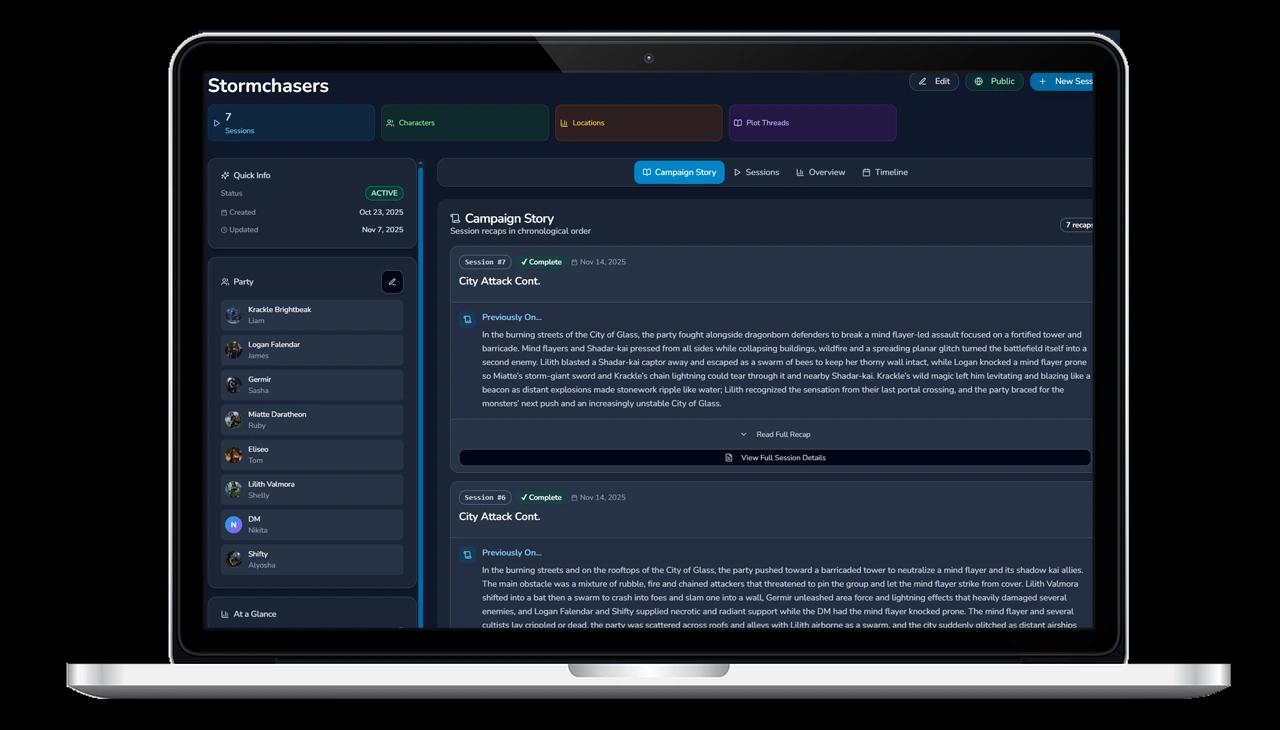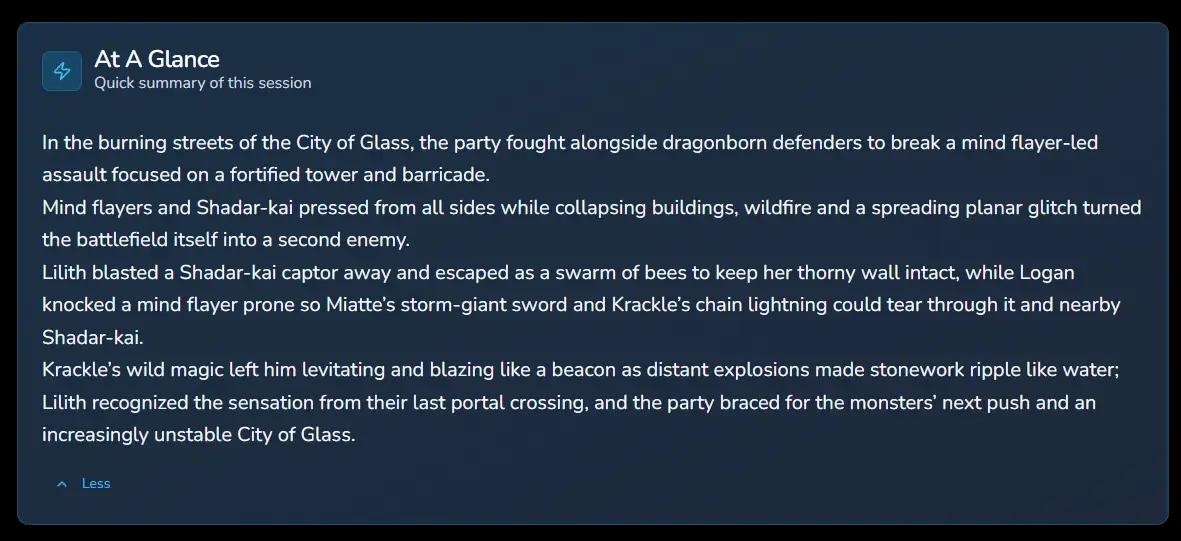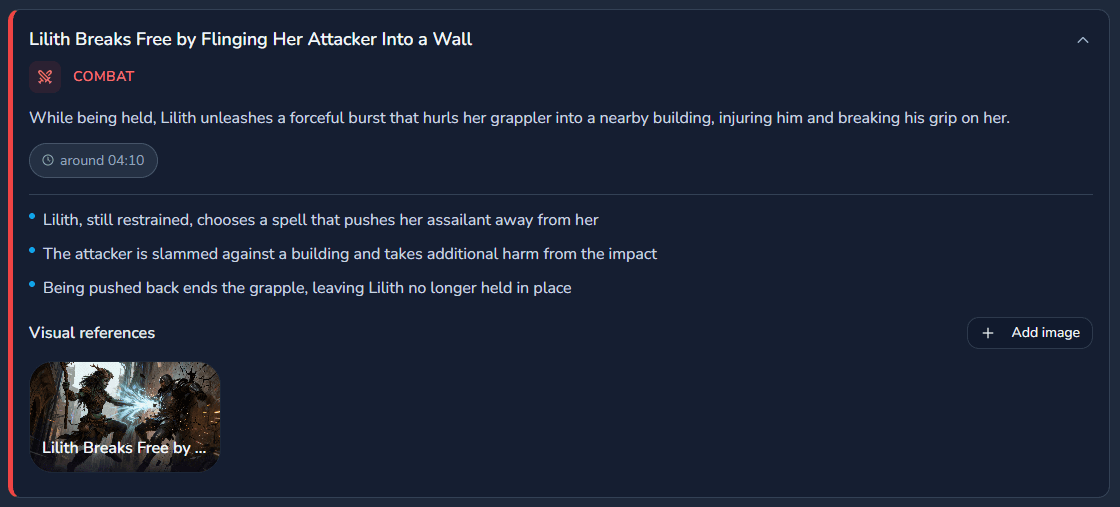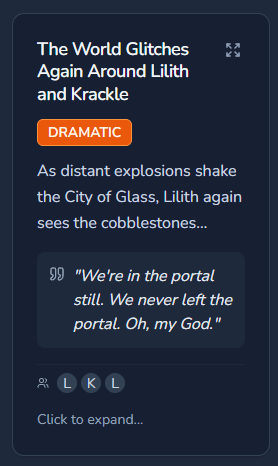Never TakeSession NotesAgain
Upload audio or transcripts. Get complete summaries plus a living campaign memory with linked NPCs, locations, and AI dossiers.
In minutes. Not hours.

How It Works
Stupid Simple
Three steps. Ten (ish) minutes. Zero manual work.
Upload
Drop your audio file or paste your transcript. 99+ languages supported.
Process
The AI extracts plot, NPCs, locations, and builds campaign memory in minutes.
Organize
Build campaign memory, AI dossiers, and generator-ready entities.
Why CharGen?
Automate your RPG session notes. Build a living campaign memory and never lose a moment.
Reduce Prep Time
Access your entire campaign at a glance. Instant summaries, session handouts, and key story moments.
Stay Immersed
Never flip through pages mid-game. Get instant answers that keep your session flowing.
Boost Engagement
Give your group real-time access to your evolving story. Players revisit key events.
Configure in minutes. Remember forever.
Complete Toolkit
Core Features
Everything you need to organize and revisit your campaign with automated notes.
Upload Any Audio Format
Support for MP3, WAV, M4A, and more. Files with automatic format detection and optimization.
Context-Aware Transcription
Fantasy-smart AI knows "Mind Flayer" not "Mine Flare". No more confusing your Human Paladin with a Kenku Sorcerer.
Character & NPC Tracking
Track NPCs, locations, and players across sessions with badges, seen counts, and one-click dossiers. Merge duplicates and keep aliases tidy.
99+ Languages Supported
From English to Japanese, Spanish to Arabic. Translate sessions between languages and handle multilingual tables.
Campaign Memory Hub
A dedicated memory view with tracked NPCs, locations, players, and a cross-session timeline. Link generators and images in one place.
Search, Export & Share
Search summaries, jump through wiki-style entity links, and export to Markdown, PDF, or JSON. Share campaigns with your players.
Session Recaps
Readable, reliable summaries of every game.
Automatically generate session recaps that highlight key events, character actions, and plot developments. Perfect for GMs, players, and late arrivals.

Key Event Tracking
What happened when? Track every moment.
See your session unfold with timestamped key events. Know exactly what happened, to whom, and when it occurred.

Highlights & Quotes
Capture the best moments of your campaign.
Never lose those epic roleplay moments, hilarious one-liners, or dramatic reveals. AI automatically surfaces the best quotes and highlights from your sessions.
Epic Moment
"I cast Fireball at 9th level!" - Theren, right before setting the tavern on fire

Living Entity Dossiers
Every NPC, location, and player stays linked.
Campaign Memory turns every session recap into a connected archive. Track entities across sessions, resolve duplicates, and keep AI summaries at your fingertips. Spin up generators from any dossier and keep visuals in sync.

New Pipeline
From Session Memory to World Assets
Turn tracked NPCs and locations into playable generators with linked images and history.
One click to generate NPCs, settlements, shops, and taverns
Your campaign memory now doubles as a worldbuilding launchpad. Use any dossier as a prompt, pick the generator type, and keep visuals synced across systems.
Campaign Entity
Miatte Daratheon
Generator Choice
Generate
Launch from dossier details with full context.
Link Existing
Attach any existing NPC or location generator.
Linked Generations
SyncedNPC Generator: Groomorlum
Linked + image sync
Shop Generator: Brightbarrel
Linked to location
Tavern Generator: The Gilded Boar
Linked to location
Comprehensive Output
Everything Generated from One Upload
Ten outputs plus a living campaign memory built from every session
Complete Plot Summary
Full narrative arc + short 2-3 paragraph recap for next session
Highlights & Quotes
Best roleplay moments preserved forever in context
Key Events Timeline
Chronological breakdown of what happened when
NPC Breakdown
Names, motivations, relationships, and repeat encounters
Locations Visited
Linked locations with history, aliases, and generator handoff
Campaign Memory
Tracked lists, candidates, merge inbox, and cross-session timeline
Entity Dossiers
AI summaries, relationships, aliases, images, and generator links
Combat Analysis
Monsters fought, spells cast, and their effects
Structured Transcript
Who said what when? fully searchable and exportable
Word Cloud & Stats
Visual breakdown of themes and recurring elements
Flexible Pricing
Pay As You Play
Use gold for transcription. 45 gold = 1 hour of AI-powered session notes.
Free
Try it out daily
Up to 11 hours/month
Plus
For weekly sessions
20 hours of transcription
Elite
Regular campaigns
44 hours of transcription
Ultimate
Multiple campaigns
100 hours of transcription
Prefer flexibility? . Never expires, perfect for irregular sessions.
Social Proof
Loved by DMsWorldwide
"This revolutionized my DMing. I can finally focus on storytelling instead of frantically scribbling notes. My players love getting detailed session summaries with character quotes and plot points!"
"As someone in three different campaigns, having accurate session summaries with speaker identification is a lifesaver. No more "wait, what happened last time?" moments."
"Perfect for new DMs! The AI transcription catches dialogue and details I would have missed while managing the game. My prep time has been cut in half."
Get Started
Ready to Stop Taking Notes?
Join hundreds of GMs who focus on storytelling, not scribbling.
Start Your First Session FreeStart FREE